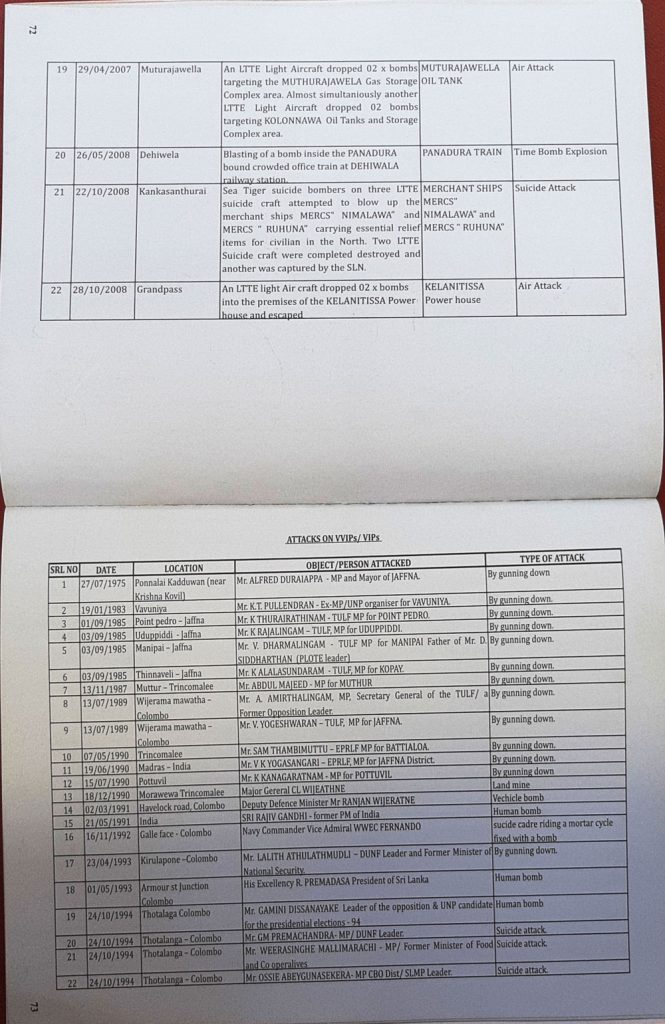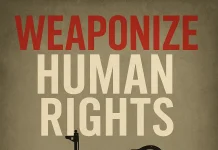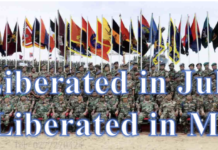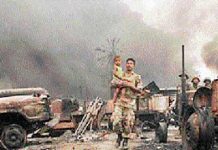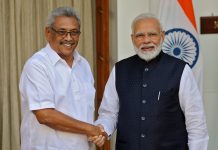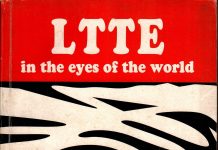
The most disciplined fighting force
The world has ever known


PREAMBLE
The Liberation Tigers of Tamil Eelam (LTTE) was vanquished by the Sri Lankan security forces after a long drawn out struggle that lasted thirty years and was marked by dislocation, destruction, death, displacement and dismemberment. ‘As always in armed conflict,’ one might add. Conflicts never end neatly, with all questions answered, all loose ends tied. Life and death in social processes never follow script. There is always the predictable and always the unforeseen. Questions remain. Time will answer some and time will bury others.
What were the last days like? What indeed were the first days like? Who did what. where and when that precipitated a particular unfolding of events in a particular sequence’? What were the contributing factors? What were the obstacles that had to be overcome? Were there hiccups and If so what caused them? Was the outcome inevitable? Were there other possible outcomes or other pathways to the final outcome? Are things better now than they were at conflict-end? Had this or that happened at such and such a time, would the net outcome have been happier for the majority of the people in Sri Lanka? And had they not, how would things be today?
Yes, certain questions will never be answered. Conjecture does not help, at times. Extrapolation is made for slippage. There are things that can be said, however. Claims that can be substantiated.
There are no complete stories. Life does not record all. Typically, we are given fragments. Fragments, moreover are made for multiple configuration. This is why there are multiple versions of all stories titled ‘What Really Happened’. We believe that sooner or later, people do figure out what is most likely to have happened. This is not a ‘piecing together’. It is not the laying out of a version with a tagline called ‘Authentic’ or ‘Authoritative’. It is a humble offering of pertinent facts that might help tomorrow’s chroniclers to navigate our tragic yesterdays without getting their metaphorical legs blown off by landmines as such are buried all over all the pathways into the past and so that minds thus crippled would not do more injustice to the victims than is par for the course for the historian.

One man’s terrorist is another man’s liberator, we’ve heard said often enough. Regardless of label, all protagonists have faces. They are judged in the here and now by what they do, what they’ve done. Things that are known as much as by things claimed to have happened. So too those who judge. And of course, those who tum a blind eye, play down, gloss over or footnote things and processes that were too real, dramatic, tragic and utterly avoidable and for these reasons did not gloss over the relevant lives, but wounded, scarred, robbed and killed.
Conflicts are made of protagonists. This is about one. The Liberation Tigers of Tamil Eelam, better known as the LITE or Tamil Tigers, described a panel appointed by the UN Secretary General, Ban Ki-moon, as ‘the most disciplined fighting force in the world’.
This is an essay on that magnificent idea. ‘discipline’. Magnificent in the allusion to systematic training and systematization, processes that correct, moulds and perfect the mental faculties or moral character. It has other connotations too, this word called ‘discipline’. It evokes the notion of punishment.It can be taken to refertoa field ofstudy. It might at times
be about control gained by enforcing obedience or order; orderly or prescribed conduct or pattern of behavior. Even self-rule is contained within the broader definition. Finally, it could be about a rule or system of rules governing conduct and activity.
‘The LTTE was the most disciplined fighting force in the world,’ someone said. It is an assertion that is truly worthy of exploration.


DISCIPLINED IN LEADERSHIP

Some are born leaders. Some have leadership conferred upon them. Some become leaders by eliminating leaders, destroying other leadership aspirants and taking out all potential threats to leadership. It is not easy. It takes hard work and meticulous attention to detail. The LTV E was disciplined. Took no chances. From Alfred Duraiappah, the Mayor of Jaffna (Sri Lanka Freedom Party), to AppapillaiAmirthalingam (leader of the Eelam-touting Tamil United Liberation Front), to all rival Tamil militant groups and their leaders, ‘upstart’ Tamil politicians who forgot to toe the LTTE line, hundreds found too late that the leadership-aspiration invited bullet. They were all killed.
K. Padmanabha and the test of the EPRLF (Eelam People’s Revolutionary Liberation Front), Uma Maheswaran and the rest of PLOTE (People’s Liberation Organization of Tamil Eelam), the Tamil Eelam Liberation Organization (TELO) of Sri Sabaratnam and the Eelam People’s Democratic Party of Douglas Devananda had to pay dearly. All, except Devananda, of the above mentioned leaders, are now dead. The parties themselves were either reduced to name boards, or submitted to the will of the LTV E in the typical manner of the vanquished.
And it was not just those ofother organizations; those considered a threat to Velupillai Prabhakaran’s authority, were systematically weeded out and murdered, the most prominent being Gopalaswamy Mahendraraja, better known as ‘Mahattaya’, Prabhakaran’s one-time deputy. Traitors, so named, were summarily executed right up to the last days of the LITE, when cadres were ordered to shoot to kill civilians held hostage by the LWV E (as part of a human shield) who tried to escape.

The LTTE was disciplined in the matter of securing the tag, ‘Sole Representatives of the Tamils’, without permission being sought by the Tamils of course. At the end of this disciplined exercise, there was no Tamil willing to seek representing authority.
The LITE was disciplined in brutality. Disciplined in relieving human beings of the burden of memory for good Disciplined in inhumanity, cowardice and ruthlessness.

DISCIPLINED IN THE DEMOCRATIC SPHERE
The LITE’s history can be traced in many ways, one of which was the deliberated and disciplined need to destroy democracy Elected officials killed by the LTTE make a long list. Prominent among the victims was RanasinghePremadasa, President of Sri Lanka. Another President, Chandrika Kumaratunga escaped an assassination attempt at the cost of an eye. The Minister of National Security, RanjanWijeratne, former Foreign Minister LakshmanKadirgamar, and other ministers and former ministers such as GaminiDissanay-ake, LalithAthuIathmudali, C.V. Gunaratne, D.M.
Dissanayake, JeyajFernandopulIe, Tamil Members of Parliament such as Amirthalingam, NeelanThiruchelvam and scores of elected members of Provincial Councils and local govemment authorities were murdered in cold blood.
The LTTE not only killed elected omcials, but coerced others to do their bidding. As a result the Tamil National Alliance, made of Tamil parties reduced to rag-tag outfits on account of their leaders being killed, emerged as the LTTE’s mouthpiece in the democratic arena. They were tasked to whitewash LTTE atrocities and to articulate the LITE’s agenda in all forums. The TNA’s election manifestos of 2001 and 2004 as well as the statements, press releases and speeches of their leaders clearly indicate pathetic servility to their political master, VelupiIIai Prabhakaran.
The ‘discipline’ in the sphere of democracy included coercing people living in areas that the LTTE controlled into either voting for candidates hand-picked by the LTTE. On occasion, the LTTE forced people to boycott elections. No candidate or parlY opposed to the LTTE ‘,vas allowed to canvass votes or even operate in these areas. Tamil parties seen to be aligned NVith the ruling party were particularly targeted. Douglas Desananda, a long-time ally of the United People’s Freedom Alliance and its political predecessor, the People’s Alliance, was particularly lucky, having survived many assassination attempts. Many of his political associates were killed.
In total, the LTTE has killed I President, I Opposition Presidential Candidate, 10 leaders of political parties, 7 cahunet ministers, 37 Members of Parliament, Members of Prosincial Councils, 22 Members of Local Government Authorities, 17 Party Organizers and 4 Mayors.
Indian Prime Minister, Rajiv Gandhi was a politician who operated in the democratic arena. He remains the most prominent non-Sn Lankan politician assassinated by the LTTE.
The LTTE was disciplined in brutality. Disciplined in relieving human beings of the burden of memory for good.Disciplined in inhumanity, cowardice and ruthlessness. For thirty years.


DISCIPLINED AMONG PUBLIC SERVANTS

The LITE killed government officials, members of the judiciary and other individuals, as and when necessary for reasons of securing control or punishing those considered to be an obstacle in achieving specific objectives. The most clinically executed of these exercises was the killing of over 600 policemen in the Eastern Province in the year 1990 in one blood-drenched day. This was, ironically, during a period when the LTTE was engaged in peace talks with the then Government of Sri Lanka. The LITE surrounded the relevant police stations. The President, intent on keeping negotiations alive, instructed the policemen to surrender to the LITE. They were all lined up and shot dead.
The LTTE was disciplined in brutality. Disciplined in mass slaughter.DiscipIined in inhumanity, cowardice and ruthlessness. For thirty years.
DISCIPLINED AMONG CIVILIANS

Vulnerable villages were regularly attacked by the LTTE, often using automatic weapons and small arms, but sometimes with swords and machetes. Women and children were killed. Pregnant mothers had their bellies slit open with swords and machetes. The sick were not spared and neither were the elderly. Children and infants were also fair game for these disciplined liberators. Close to 2000 civilians are estimated to have been killed in these attacks. The targets were mainly Sinhala villages, but Muslims were not spared either The attack on a Muslim village in Eravur, Batticaloa in August 1990 saw 173 civilians being killed.
Villages and villagers were not the only civilian targets of these disciplined terrorists. The LTTE carried out attacks through the length and breadth of the island using vehicle bombs, suicide bombers, time bombs, claymore mines and armed attacks. Over 9,800 civilians are estimated to have been killed in these attacks with more than a 10,000 being injured.

The deadliest attacks include the one on the Central Bus Station, Colombo in 1987 which took the lives of over 100 civilians. The truck bomb targeting the Central Bank in 1996 killed 86 persons, injuring over 1,300. Over 120 devotees at the Sri MahaBodhiya, sacred to all Buddhists, were shot dead in an LTTE shooting spree in 1985. Thirty seven civilians including 33 novice Buddhist monks were killed when the LTTE ambushed the bus they were travelling in, dragged them into the surrounding jungles and shot them in cold blood. This was in 1987. The LTTE also killed 147 Muslims who were praying in a mosque in Kattankudy, Batticaloa in 1995.
Buses were attacked. Bombs set off in trains and train stations. Places of religious worship were not spared. Crowded places particularly came under threat. The LTTE paralyzed civilian life. Every single citizen of Sri Lanka was forced to be constantly vigilant about bomb threats. Parents didn’t travel together. fearing that a bomb would leave children orphaned. No one could be certain that loved ones would be seen again once they left home to school or work or even to visit friend, relative or the sick. Such was the nature of the LTTE’s shadow of discipline that enveloped the island.
The LTTE was disciplined in brutality. Disciplined in mass slaughter-Disciplined in inhumanity, cowardice and ruthlessness-For thirty years.


DISCIPLINED In ENGAGING KEY INFRA STRUCTURE FACILITIES

The LTTE was not fighting to secure of a part of the country. Perhaps as means to an end, but need to destroy, the LTEE targeted key nodes ofthe economy. In addition to the attack on the Central Bank, the LTTE attacked the Colombo International Airport in July 2001, destroyed several passenger jets and helping cripple the all-important tourist industry for several years. The Kolonnawa Oil Refinery was attacked several times. The Central Telecommunication complex was attacked in 1986 and the World Trade Centre in 1997. As mentioned before, the LTTE attacked crowded places such as bus and train stations as well as supermarkets and crowded intersections, exploded bombs in buses and trains, and in many other ways sought to bring economic activity to a standstill.
Yes, the LTTE was disciplined; disciplined in inhumanity, cowardice and ruthlessness.


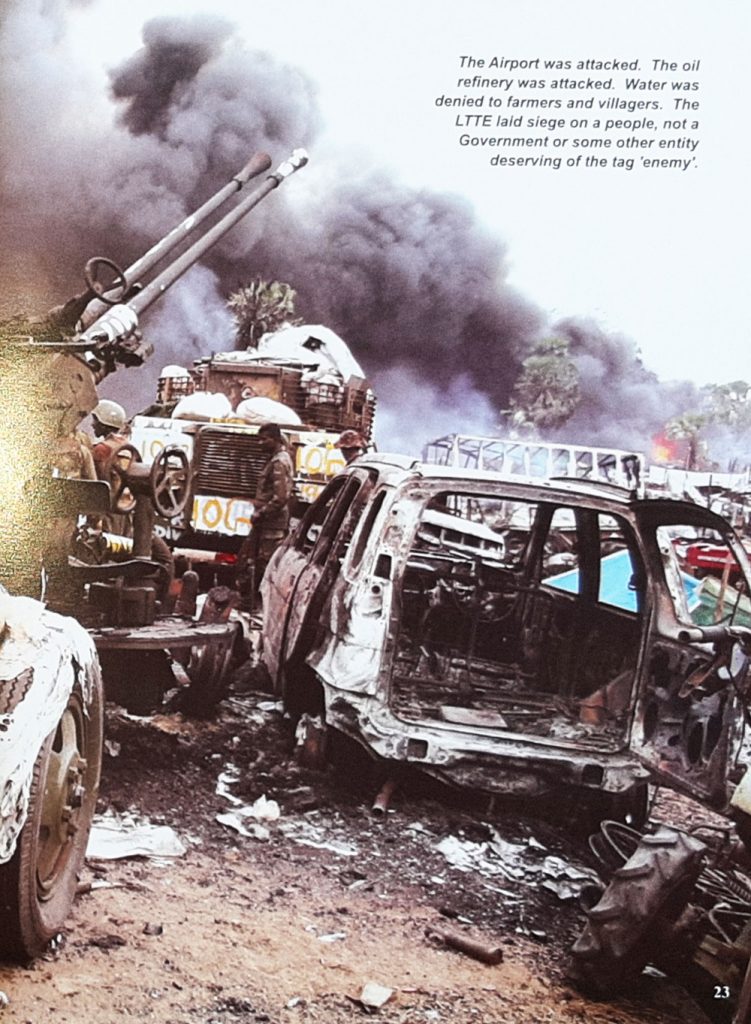
deserving of the tag ‘enemy’.
DISCIPLINED IN ETHNIC CLEANSING A GENOCIDE
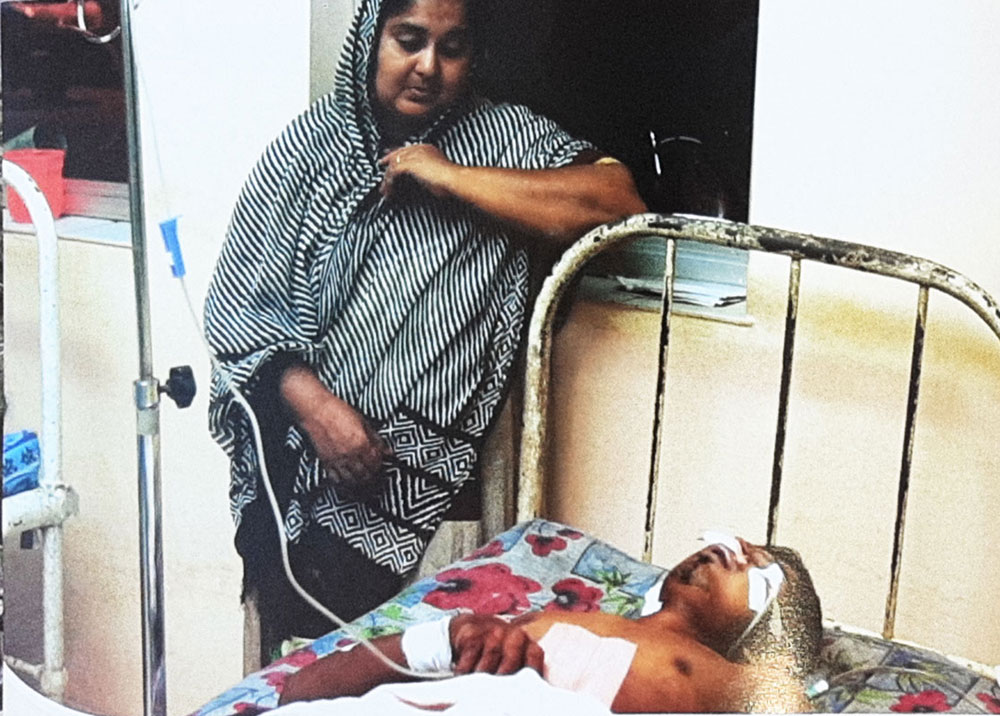
‘Ethnic Cleansing’refers to a purposeful policy designed by one ethnic or religious group to remove by violent and terror-inspiring means the civilian population of another ethnic or religious group from certain geographic areas. It is obtained by means of murder, torqure, arbitrary abduction and detention, summary execution, rape and sexual assault, forcible removal, displacement and forced eviction of civilian population, deliberate attacks or threats of attacks on civilians and civilian areas, and wanton destruction of property. Those practices constitute crimes against humanity and can be assimilated to specific war crimes.
Genocide refers to killing members of a particular group of people defined by shared identity such as ethnicity, religious persuasion, colour etc.; causing serious bodily or mental harm to members of the said group; deliberately inflicting on the group conditions of life, calculated to bring about its physical destruction in whole or in part; imposing rneasures intended to prevent births within the group; forcibly transferring children of the group to another group; with the intention ofdestroyed the group, in whole or in part.
The LTTE was determined and disciplined in carving for its sole-control a mono-ethnic territory. To this end, the LTTE systematically attacked villages inhabited by Sinhalese and Muslims, Inurdering civilian by the dozen and forcing others to flee in their thousands to other parts of the country.

Those who cry foul at communal violence relinquish all moral high ground when unleash violence on other communities. The Muslims in Jaffna were unceremoniously asked to abandon their traditional homeland. This was ethnic cleaning long before Kosoovo pushed that term into the political lexicon.
The LTTE systematically drove out all Sinhala residents from the Jaffna Peninsula beginning from the early 1980s. Over 500 Sinhala civilians in the Northern and Eastern Provinces of the country were killed during that decade and so too 150 villagers located in areas proximate to those controlled by the LTTE. A total of 19,334 Sinhalese were recorded as living in the Northern Province in the Census of 1981. Almost none remained a few years later. Yes, the LTTE was disciplined in its genocidal operations.
The most systematic exercise in ethnic cleansing by the LTTE was carried out in October 1990 when this disciplined organization ordered approximately 75,000 Muslims resident in the Jaffna Peninsula to leave their homes within 48 hours. They were duly relieved of all their money and all their jewellery. There was no pity for pregnant mothers, infants, the sick and dying or the elderly. Forty eight hours. This was the most disciplined and clinically executed exercise in ethnic cleansing the island has ever seen.
The LTTE was disciplined in fracturing communities. Disciplined in displacing people. Disciplined in genocide.DiscipIined in ethnic cleansing. Disciplined in inhumanity, cowardice and ruthlessness. For thirty years.
DISCIPLINED IN CHILD-CARE

Was it only non-Tamils and the Sri Lanka state that these disciplined ‘liberators’ targetted, though? No. The ETTE forcibly conscripted almost all able-bodied Tamil men and women, gasc them weapons training and deployed them In military and terrorist activities including suicide missions, cold-blooded assassinations and brutal attacks on unarmed civilians.
No one was spared. Not even children- Tamil parents who saw their children OIT to school could never be certain if they would return. Hundreds •sere abducted on their way to school or on their way hotne, relieved of school uniform and books and forced to don military fatigues and carry guns, grenades and bullets. Children as young as 10 years of age were abducted by the LTTE. This the LTTE’s ‘Baby Brigade’, a tragic tag which perhaps morethan any other descnbes the horror that was the LTTE
Even in the last days, LTTE was not loathe to deploy children as suicide bombers. VelupillaiPrabhakaran sent one such innocent, explosives strapped Lo his person, to mingle with those who were fleeing into Govemment-controlled areas. The explosion was timed at the moment he reached the relevant ‘Receiving Centre’ in order to deter others from fleeing. A child in pieces.
The LTTE was disciplined in brutality. Disciplined in mass slaughter. DiscipIined in inhumanity, cowardice and ruthlessness. DiscipIined in ‘taking care of children’. Disciplined in robbing children of childhood. And life.

This was the future apparent and unavoidable, the future that agonized child and parent, the future that Involved dispenslng death and bereavement. The future that is no longer future nor one to take eyes away from, in fear or horror or both.

The LTTE coined a term: Child Soldier. They coined another: Baby Brigade. The systematically robbed Innocents of innocence and childhood. They were very disciplined In this.

The killer and the killed were both children. Only a clinically disciplined leader and organization could srategize In ways to produce this horrendous outcome.
DISCIPLINED IN NEGOTIATION

It was not always about combat and hostility. There were moments during those 30 years when the LTTE agreed to negotiate with the governments ofthe time. There were ceasefires too, some infonnal, some not, for example the Ceasefire Agreement of 2001, underwritten by Norway.
Lawrence Thilakar, one time LTTE spokesperson in Europe, put all these lull- periods in perspective once: ‘The LTTE views all negotiations and ceasefires through a military lens’. He was correct. It was all about obtaining relief when cornered, securing breathing space, and opportunities to regroup, re-arm, recruit and rest.
The Thimpu Talks (July 8, 1985 toAugust 17, 1985) was thefirst attempt by the Government of Sri Lanka to negotiate a peaceful settlement to the conflict. LTTE was one amongst several Tamil groups that participated, the others being the Tamil United Liberation Front (TULF), the Tamil Eelam Liberation Organisation (TELO), the People’s Liberation Organisation of Tamil Eelam (PLOTE), the Eelam People’s Revolutionary Liberation Front (EPRLF) and the Eelam Revolutionary Organisation of Students (EROS).
The Tamil groups insisted that certain demands had to be met prior to proceeding with the discussion, effectively scuttling negotiations.
The LTTE, however. used the ceasefire granted by the Government of Sri Lanka accompanying these talks as a means to strengthen itself militarily. Thus, shortly after the breakdown of the talks, the LTTE was able to take control over the JafTna Peninsula. During the ceasefire period, the LTTE had purchased a number of M-16s, AK-47s and Rocket Propelled Grenades (RPGs) and large quantities of explosives and they used these weapons and explosives extensively against Security Forces and civilian targets. The other militant groups, less disciplined, were duly taken out of both military and political equations by the LTTE.
Using international contacts established during the Thimpu Talks, the LTTE purchased its first ship named “Cholan” in 1986.
This marked the beginning of its international shipping nctwork.
Then came the Indo-Lanka Accord of July 1987. This was when the security forces had viruaily cornered the LTTE in the North. Indian intervention saw the then Government of Sri Lanka agree to a cessation of hostilities. Subsequently the Indo-Lanka Accord was signed in Colombo on July 29, 1987, between Indian Prime Minister Rajiv Gandhi and Sri Lankan President J.R. Jayewardene. This led to the arrival ofan Indian peacekeeping force in Sri Lanka (IPKF). The Government of Sri Lanka took the concrete step of amending the national constitution, adding a thirteenth amendment that provided for a provincial system of governance, the Provincial Council system. Subsequently, by Gazette Notification, the Northern and Eastern provinces were merged.
The LTTE was required to surrender its arms, together with all other militant groups. Unlike all the others, the LTTE only made a token and insignificant handing over of some weapons, and instead used the ceasefire to further consolidate its power in the North and East. On 1 October 1987, just four days after falsely claiming it had surrendered all its arms, the LTTE launched a pogrom against Sinhalese civilians in the East, killing 211 within two weeks and wounding 39.
Shortly thereafter, 17 LTTE cadres were arrested when they were caught on board two trawlers laden with arms, ammunition and explosives. Prior to being brought to Colombo for law enforcement action, eleven of the LTTE cadres committed suicide on 5 October 1987 by ingesting potassium cyanide smuggled in by the LTTE.
Within a few days the LTTE reacted by attacking two army camps and murdering eight soldiers in their captivity and killing 23 civilians. A few days later, the LTTE killed half a dozen Indian soldiers. This open hostility of the LTTE, following its refusal to surrender arms, led to the Indian Peace Keeping Force (IPKF) becoming an active participant in the conflict. The IPKF directly fought the LTTE for the following two years, during which the LTTE killed 1,138 Indian soldiers and wounded 2,762 according to IPKF records.
The third attempt at negotiations was launched two years later and went on from May 3, 1989 to June 10, 1990. It was the same story. An LTTE need for respite, this time from the IPKF. The
then Government of Ranasinghe Premadasa secured a ceasefire between the IPKF and LTTE and persuaded the latter to cease operations altogether and leave the island on June 8, 1989. In order to show good will, the Government agreed to a number of LTTE demands, including the closing down of several strategic Army camps. The LTTE, true to form, made further demands.

It was during the second round of talks, i.e. on June 11, 1990 that the LTTE surrounded and attacked over a dozen police stations in the East, taking hundreds of police officers as prisoners, killing some 600 in cold blood, as mentioned above. It was also during this recouping honeymoon that the LTTE assassinated the leader of the TULF, A Amirthalingam and V.
Yogeshwaran, TULF MP for JafTna. Sam Thambimuttu, MP of the EPRLF, was also killed in May 1990.
It was also during this time that the LTTE started launching suicide attacks against naval craft, the first being at Velvettithurai, Jaffna, where the Black Sea Tigers made an attempt to ram an explosive laden boat on the Sri Lankan Naval vessel Edithara.
The ceasefire that was more ‘cease’ on the part of the Government and ‘fire’ by the LTTE was duly scuttled. Ina very disciplined manner.
The fourth such attempt was between October 13, 1994 andApriI 18, 1994, i.e. after Chandrika Kumaratunga announced talks” with the LTTE within days of assuming office as Prime Minister on August 17, 1994. Subsequently, a “Declaration of Cessation of Hostilities” was agreed upon, that provided for both the LTTE and Security Forces to maintain their then positions on the ground. The LTTE, however, steadfastly refused to engage in any discussion on substantive political issues until a series of additional demands, none of which were provided for in the Ceasefire Agreement, were agreed to by the Government. These demands included that the Government of Sri Lanka remove a strategic Army Camp at Pooneryn, open up a strategic land route to the mainland for LTTE use, allow LTTE cadres to carry arms in the East, and exempt LTTE cadres from checkpoints and screening on roadways.
The LTTE scuttled this round of negotiations by blasting two naval gunboats in the Trincomalee Harbour, killing 12 sailors and wounding 21 others.
During this period the LTV E formed four new Infantry and Support Arms Regiments namely Anbarasi (anti-aircraft), Malathi (female infantry regiment), Kittu (artillery regiment) and Victor (anti-tank regiment). They also purchased large quantities ofartillery guns, anti- aircraft and anti-tank weapons and explosives from Eastern European and Eastern Asian countries. They also secured Surface-to-Air missiles. The costs were bourne, naturally, by the security forces.
Very disciplined was the LTTE during these times of negotiation.

Finally, there were the negotiations facilitated by Norway and marked by the Ceasefire Agreement (February 22, 2001 to January 8, 2008).
The Government of Norway functioned as facilitator of the peace process, coordinating communication between the parties and arranging logistics before and during the peace talks. In addition, the Sri Lanka Monitoring Mission (SLMM), comprising members from Nordic countries, was appointed to supervise the implementation of the ceasefire agreement. The SLMM monitored events on the ground and was required to make determinations regarding allegations of ceasefire violations in keeping with their mandate. In addition, the govemments of the United States, Japan and Norway and the European Union were appointed as Co-chairs of the Tokyo Conference on Re- Construction and Development ofSri Lanka on June 10 2003, and in this role served to encourage the peace process through the provision of funding for economic development projects in the North and East. Since this was the most important of these ‘negotiations’, let us quote in full the Ministry of Defence on the subject.
33
=== Page 7 OCR Scanning Started ===
3 34
As in previous peace talks, the LTTE insisted on numemus concessions hi’ the Government of Sri Lanka and pre-conditions below it would sit down to negotiate. These included demands to ease mstrictions on transport q/ dual purpose (civilian and military) goods to LTTE- controlled areas, provision of transportation for LTTE cadms. access to foreign funding, supplying of communication equipment and access to international training programs for its cadies. The LTTE stated that these were necessary for “confidence building ” and “humanitarian masons, ” but did not allow any concessions to the Government of Sri Lanka. Despite the Government ofSri Lanka’s granting ofalmost all of the LTTE’s demands during this time, the LTTE still balked, stalled and ultimately walked out of the peace talks when it was time to commit to taking action on substantivepolitical issues. Although them was a standstill with regard to the resumption of the peace talks, the ceasefire continued, mainly because the LTTE continued to benefit from the ceasefire and waited for an opportune moment to break it.
Shortly after winning the pesidential election in November 2005, President Mahinda Rajapaksa successfully restarted the stalled talks with the LTTE. Aware of the LTTE’s tactics of insisting on short-term demands whilst avoiding discussing substantive political issues, the Government of Sri Lanka delegation this time refused the LTTE’s demand to limit the discussion to the ceasefire agreement and instead insisted on an open agenda. Whileprogress was made in beginning the dialogue on an array of issues in the first round of peace talks under President Mahinda Rajapaksa, the LTTE subsequently reverted to its usual tactics and made logistical excuses and additional demands that had the effectofhalting the talks.
In June 2006, the LTTE delegation took the opportunity toJIy to Oslo, Norway for a round of scheduled talks with the Government of Sri Lanka, but refused to show up for the negotiation session, stating that they were not satisfied with the composition of the Government of Sri Lanka delegation. In the last round of talks in October 2006, the LTTE refused to proceed with further peace talks until the Government of Sri Lanka agreed to open up the A-9 highway, a demand that the Government of Sri Lanka could not meet for security reasons. When talks broke down this time, however, the LTTE had achieved what it needed under the ceasefire agreement and was ready to resume hostilities.
LTTE behaviour during 2002-2006
From the signing of the Ceasefire Agreement in February 2002 by the Government led by Prime Minister RaniI Wickremasinghe, until the breakdown of peace talks in October 2006, the LTTE significantly and measurably increased its military strength. There is documented evidence that the LTTE exploited the ceasefire period to rearm and build stockpiles of weapons and ammunition, engage in a large-scale recruitment drive to markedly increase its strength, and assassinate its political opponents to consolidate its power in the North and East. During this period, the LTTE also engaged in a campaign to provoke, threaten and demoralize the Security Forces, who were precluded from retaliating due to their adherence to the terms of the ceasefire agreement. LTTE also repeatedly and systematically violated the ceasefire agreement, increasing the frequency and seriousness of such violations beginning in late 2005. The massive number of violations confirmed by the SLMM make clear the LTTE’s contempt for the Ceasefire Agreement.

Acquisition of arms and ammunition
LTTE engaged in upgrading weapons systems and stockpiling large quantities of weapons during the ceasefire. The LTTE managed to procure a number of anns consignments from abroad and was successful in unloading them to its strongholds in Mullaitivu utilizing sea mutes. These armaments included the consignment of large quantities of personal weapons, mines, artillery guns, aircraft, missiles and large quantities ofexplosives. The LTTE maintained a fleet of merchant vessels that transported weapons for the group. These vessels would voyage to international waters off the coast of Sri Lanka and transfer consignments of weapons to multi-day fishing trawlers that would smuggle them to the coastline. Details of the reported arms procurements and methodologies are available in Annex J.
The detection of such weapons laden trawlers by the Sri Lanka Navy with SLMM ceasefire monitors is recorded in the SLMM reports of 14 July 2002 and 10 February 2003. In these instances the SLMM ceasefire monitors on- board the Sri Lanka Navy vessels documented evidence of weapons tramsfer by the LTTE during the ceasefire. The detection and destruction of 10 LTTE vessels carrying thousands of tons of weapons and equipment by the Sri Lanka Navy between the period of September 2006 to October 2007, establishes empirical evidence on the modus operandi used by the LTTE to transport weapons during the ceasefire.
Acuisition of aircraft

The LTTE, which had earlier been limited to land and sea, added a new diniension to its warfare by introducing aerial attacks with the use of aircraft that were procured during ceasefire. The LTTE also exploited the ceasefire by managing to send its cadres abroad for flight training and built a number of airfields during this period.
Recruitment of cadres
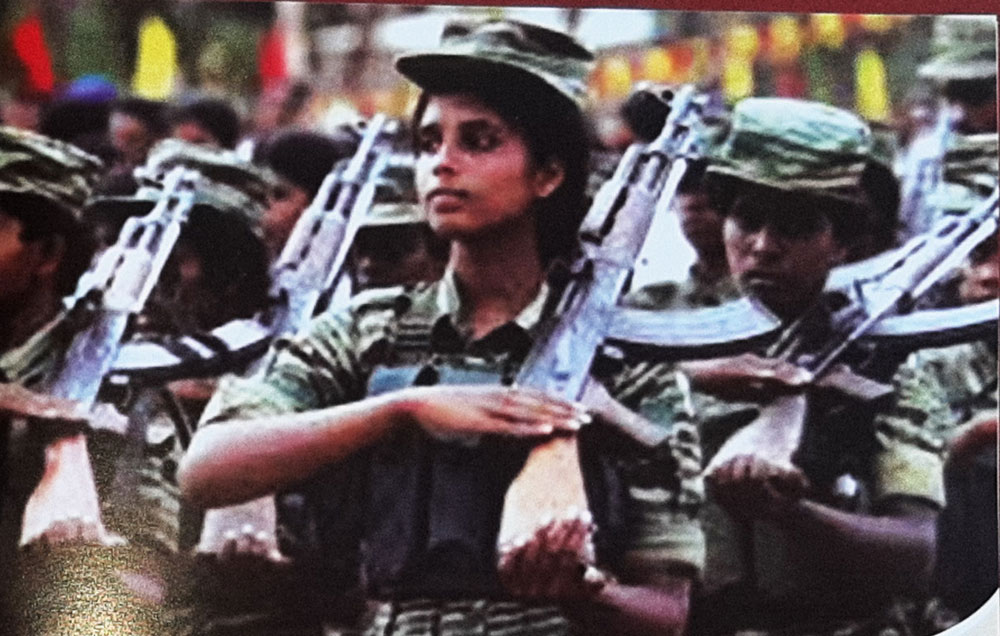
The LTTE also capitalized on the ceasefire period by significantly increasing its recruitment activities, including in Government controlled areas. This included forcible abduction of adults and children. The SLMM determined that the LTTE was responsible for 1,743 instances of child recruitments, 253 abductions of children and a further 579 abductions ofadults during the ceasefire. These SLMM records only refer to complaints made by relatives to the SLMM regarding LTTE recruitnlents and abductions. As the SLMM did not have a process to monitor CFA obligations and receive public complaints in areas contmlled by the LTTE, it is likely that a substantial number of such incidents in these areas have not been reported.
The LTTE also significantly increased the strength of its auxiliary forces, and provided mandatory training to civilians within its areas of control. LTTE’s recruitment drive during the ceasefire period led to a significant increase in its strength: from a strength of less than 14,000 cadres in 2002 it grew to 25, 000 cadres by June 2006.
Exploitation of LTTE ‘Political Offices’
Under the ceasefire agreement, the LTTE was permitted to engage in political activity in government controlled areas. It was the expectation that the LTTE would make best use of this opportunity to transform from a militant organisation to a political one. Unfortunately, the indulgence of the Government of Sri Lanka to facilitate such a transition was misused by the
intransigent LTTE. For example. the ceasefire agreement povided for LTTE combatants to enter government controlled areas, which resulted in the LTTE establislling several “LTTE Political Offices ” in areas contmlled by the Government of Sri Lanka. The LTTE used to organize these “Political Offices recruitments drives, spearhead intelligence efforts, collect arms and threaten and intimidate residents.
Strengthening of international funding and arms procurement operations
During the ceasefire, the LTTE actively engaged in restructuring its international network to impove itsfundraising and weapons procumment operations. In July 2003, the international coordination centre of the LTTE convened a meeting of key leaders of the overseas branches and provided them direction as to the re-organising the international network. This re-mganisation took effect immediately and the Tamil Diaspora was persuaded or, in many cases, coerced to contribute money towards the resumption of war. The LTTE message to the Tamil Diaspora was that Iwge sums offunding is required as the LTTE was preparing for a decisive battle to achieve its goal which was refened to as the final war.
The LTTE exploited even source of revenue to sustain itsfast growing expenditure and develop military infrastructure facilities in the North and East area during the ceasefire, including usingfunds it received following the December 2004 tsunami. The LTTE collected funds from overseas in the guise of utilising the funds for development and rehabilitation work in the North and East. The funds were channelled though itsprimaryfront cuganisation the Tamil Rehabilitation Organisation (TRO), which was later banned by several countriesfor supporting terrorism. The LTTE also established an illegal bank during the ceasefire, the “North and East Development Bank, ” based in Killinochchi, and channelled money from the TRO to this bank.
Assassination of opponents
During the ceasefire period, the LTTE comm issioned a fresh campaign of assassinations twgeting its opponents. The LTTE used its newly-fonned “political offices ” in government contmlled amas to plan and support these covert operations. An LTTE sn i per killed Foreign Minister Lakshman Kadbgamar in August 2005, and Kethesh Loganathan, the Deputy Secretary General of the Secretariat for Cooldinating the Peace Process, was shot and killed outside his home in August of the following year. During the ceasefire, the LTTE also killed a number of Tamil political party leaders and members who had opposed it and entered the democratic mainstream.
Acts ofprovocation
After the signing of the ceasefire agreement in February 2002, LTTE gradually incmased its povocative acts against Security Forces, attempting to provoke the Security Forces to react and violate the ceasefire agreement. These included several acts of intimidation, inclusive of abductions, attacks and assassinations tcugeting the Security Forces, as well as smaller acts that attempted to elicit an immediate response. At checkpoints throughout the North and East, the LTTE engaged in taunting, throwing stones, spitting and other acts intended to humiliate individual soldiers. Thew are several incidents where LTTE cadres in civilian attire brutally attacked and killed Security Forces personnel while they were on patrol on the streets in Government contmlled areas. LTTE cadres dressed in civilian clothing also engaged in acts such as burning tires on the street, blocking traffic and otherwise disrupting civilian life. Despite these provocations by the LTTE, Security Forces acted with restraint in keeping with the spirit of the ceasefire agreement.
Violation of the CFA

Between February 2002 and May 2007, the SLMM ruled that the LTTE violated the ceasefire 3,830 times, compared with just 351 violations attributed to the Government of Sri Lanka. It should be noted that the SLMM monitoring and ability to investigate complaints was limited by its permitted role and resources, particularly in LTTE controlled areas. Therefore, it is likely that the LTTE violated the ceasefire far more times than even this number indicates.
After the LTTE was banned by the European Union, the LTTE retaliated by saying that it could no longer guarantee the safety of SLMM personnel. As a result of these threats by the LTTE, the SLMM significantly reduced its presence and role in Sri Lanka from September 2006. From May 2007, the SLMM ceased making determinations on ceasefire violations. Given the SLMM’s inability to consistently investigate complaints made against the LTTE in LTTE controlled areas, and the reductions in its personnel and presence necessitated by LTTE provocations, it is prudent to also examine the record of complaints made against the LTTE during the ceasefire period.
It should be noted that while the ceasefire agreement formally ended on 16 January 2008, the ceasefire was effectively over by July 2006 due to the LTTE’s marked increase in violence and effective abrogation of the agreement subsequent to this time.
Yes, the LTTE leaders were very disciplined ‘negoitators’. They were aces at exploiting such moments to buttress warring capacities. They were no couch potatoes.
DISCIPLINED IN CULTIVATING FRIENDS IN HIGH PLACES

Tamil Nadu was always safe haven and some argue the true address for Tamil Nationalism. Here’s Vaiko, the vociferous Indian agent of the LTTE, with the Supreme Disciplinarian, Velupillai Prabhakaran, chit-chatting and in LTTEcombatfatigues.
The LTTE, then and now, knew the importance of establishing, maintaining, strengthening and expanding and extensive international network, not just for fundraising and arms procurement but also for efficient propaganda work. The LTTE systematically cultivated friends among politicians and administrators as well as officials in important multilateral and regional bodies. They in turn for a variety of reasons went along with the LTTE’s well-crafted tall tales which included turning myth into fact and the easy switch of lie as truth for their own purposes.
To this end, the LTTE had in place a considerable network of international operators, some engaging in criminal activities and others in apparently white-collar propaganda. Until the LTTE’s military arm was vanquished, they operated as humanitarian fronts or political groups that whitewashed the LTTE’s crimes against humanity and vilified the Sri Lankan security forces. They all raised funds through criminal activity including extortion, gun-running, human- smuggling and drug-trafficking as well as through legal means such as real estate operations, shipping businesses etc.
At present the LTTE / Pro LTTE international network could be broadly categorized into five groups with grand-sounding names: Provisional Transnational Government of Tamil Eelam (PTGTE), Tamil Eelam Peoples’ Alliance/Tamil National Alliance (TEPA/TNC), Global Tamil Forum (GTF), British Tamil Forum (BTF) and the Ex- combatant/intelligence group. Though roles, tasks and policies of these groups invariably overlap, all of these groups are working for a common agenda of establishing a separate state for Tamils in Sri Lanka. They are all led by known LTTE operatives such as V. Rudrakumaran, S.J. Emmanuel (the terrorist in a cassock), Suren Surendiran and P Sivaparan alias Nediyawan.
They’ve succeeded in securing the tacit or open support of high profile international actors such as David Miliband, Bernard Kouchner, Eric Solheim, Navi Pillai, Louise Arbour and others.
DISCIPLINED IN THE WORLD OF LAW AND ORDER
There is no point being prepared to be clinical and disciplined in the matter of terrorism if you don’t have the required hardware. Guns, grenades, bullets, explosives and other military equipment including communications devices have to be purchased. Money is needed. The LTTE was very disciplined in money-making. Over the years, the LTTE, in a very disciplined manner, established a transnational criminal network that complemented its ‘very disciplined’ international propaganda machinery used to whitewash disciplined crimes against humanity, paint terrorist as rebel or liberator and vilify governments mandated to protect territorial integrity, sovereignty, property and the lives ofits citizenry.
The LTTE began its narcotic smuggling operations in Europe way back in the 1980s. The LTTE’s one time drug couriers formed trafficking groups located in Europe and SoutheastAsian countries. Numerous arrests of LTTE cadres have been made abroad. In 1986, a former head of the LTTE International Secretariat was arrested and convicted in France for smuggling illicit drugs into Paris.
The LTTE’s involvement in human trafficking also dates back to the 1980s. The earliest known case involving the LTTE was when 155 Tamils were smuggled into Canadian waters from West Germany and set adrift in lifeboats. In subsequent years, the human trafficking operation was run from certain Southeast Asian nations including Cambodia, Laos, Thailand, Indonesia, Malaysia and Singapore, which became transit points and gateways to western states. The LTTE’s involvement in human trafficking has been reported in the Thai port of Songkla, where a small vessel with a Sri Lankan crew was seized, and in the city of Pattaya, where 49 Sri Lankans were arrested in an apartment in 2005. The latest case reported in connection with the LTTE’s involvement in human smuggling concerned the two vessels “Sun Sea” and “Ocean Lady”, which travel led from South EastAsia to Canada in 2010.
Extortion was a key mechanism of filling the LTTE’s war chest. Contributions for operations Were secured from members of Tamils living in other countries. While some contributions were voluntary, intimidation, threats and violence were used to collect a significant amount of these funds. Those who resisted contributing were told that no guarantee could be given about the safety of their relatives still living in Sri Lanka, nor could their safety be guaranteed if they returned to Sri Lanka. Moreover, these ‘victims’, a large number who had fooled immigration authorities in countries they are now domiciled in claiming they were political refugees (who nevertheless visited Sri Lanka several times subsequently), had personal stakes in perpetuating the conflict for it legitimized their claim to remain in these countries.
It is estimated that the LTTE raised funds on the scale of USS 50 — 75 million each year between 1993 and 2002, and over USS 200 million on an annual basis from 2002 to 2008. These funds were laundered through the LTTE’s sophisticated international financial nei,work using hard to trace, document-less transactions. Some of the funds raised were transferred to Sri Lanka through LTTE front organisations such as the Tamil Rehabilitation Organisation and utilised for the LTTE’s local expenditure, while the bulk of the funds was used for its international procurement activities.
Yes, the LTTE was disciplined in extortion, disciplined in theft, disciplined in human smuggling, disciplined in gun-running and drug-trafficking, disciplined in credit card and other kinds of fraud, and disciplined in cooperating with other terrorist outfits all over the world.
DISCIPLINED IN GETTING PROSCRIBED

It took the world many years to take terrorism seriously. It was after the 9/11 spectacle that the term ‘Global War on Terror’ entered the political lexicon. Many countries before and after that landmark act of terrorism were not unaware of what the LTTE was up to, although many remained silent, looked the other way and even gave the occasional back-pat since they LTTE had tllrough threat and other means forced Tamil communities in certain parts to lobby on its behalf using their newly gained citizenship and bloc-vote strength.
The LTTE has been designated and proscribed as a terrorist organisation in 32 countries, including India (since 1994), the United States (since 1997) the United Kingdom (since 2001) and the European Union (since 2006).
The Tamil Rehabilitation Organisation (TRO), one of its key fronts and primary conduits of fund-collection in the name of charitable activity, was designated as a terrorist organisation and banned in the United States in 2007, and delisted as a charity in the United Kingdom since 2005.
Yes, they were disciplined in ruthlessness, disciplined in their cowardice and this discipline was recognized by the world. Formally.
DISCIPLINED IN HOSTAGE-TAKING

The LTTE took the entire country hostage through its many acts of terrorism as described above. The LTTE held the Tamil community in other parts of the world hostage too and through them their elected representatives in foreign govemments. Most tragically, the LTTE held hostage the very people it claimed to represent and promised to ‘liberate’ from perceived enslavement, the Tamils in the Northern and Eastern parts of the country and their elected representatives, in particular the TNA, pathetically reduced to operating as mouthpiece ofagun-toting thug. Took a lot ofdiscipline.
The LTTE’s first significant act of hostage- taking was in July 2006, when it shut down the sluice gates of MaviIAru, depriving water to 9,510 Muslims, 8,013 Sinhalese and 4.439 Tamils living in 20 villages, crippling their livelihoods. Once the security forces secured control of the sluice and liberated the affected population from the horrors of thirst, the LTTE realized that it could no longer count on civilian support. ne LTTE, past masters at scuttling all chances of peaceful negotiations and inviting a war that no one wanted, found that the Tamil people no longer trusted them to deliver promised Paradise and that they probably suspected that the purported enemy offered a far more pleasing proposition. This was the beginning offomal hostage-taking.
The LTTE, which had on occasion used people as human shields, had to use this mechanism as an everyday method of protection. Not only did the LTTE set up artillery installations among civilians, they would slip out of fatigues and into civvies to blue distinction between combatant and civilian. From ‘MavilAru’ to the total liberation of the Eastern Province and from ‘Silavatura’ northwards and thereafter eastward, the LTTE dragged the civilians at gun point as they retreated further and further into their strongholds.
On the last days of ihe conflict, the LTTE had a human shield comprising more than two hundred thousand civilians. The killed in cold blood those who slowed them, including cadres injured in the conflict. When the end was imminent and recognized as such, the human shield disintegrated. People fled, braving the bullets of their would-be liberators. Hundreds were killed. They were all Tamils. Civilians.
Yes, they were disciplined in hostage taking. And hostage ‘taking out’. Disciplined in brutality and ruthlessness, disciplined child- snatchers, disciplined criminals, disciplined
hoodwinkers of naive sections of the international community.

The LTTE laid siegc to a nation. It held an entire population hostage, but no onc in such miscrablo and hapless conditions as the approximately 300,000 Tamil civilians it forced at gun point to follow as the terrorists retreated in the face of advancing troops. They were very disciplined in establishing a human shield of unprecedented proportion. And thoy thanked thosc innocont pooplo by shooting them in cold blood as they tried to escape.


ANNEXES
.




